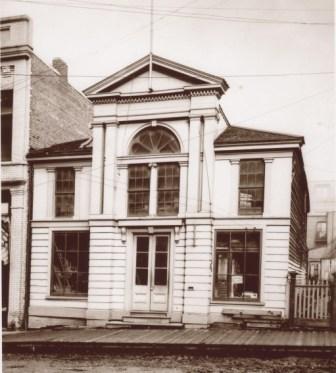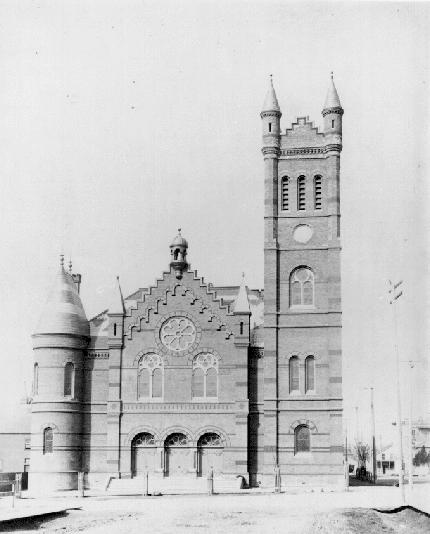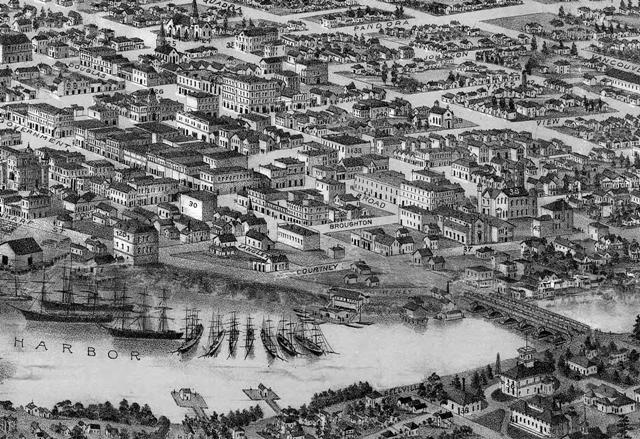Why did it take so long for a Presbyterian Church to be established in Victoria?
In the 19th Century the Church of Scotland was heavily committed in supporting missions around the world. The demand for new missionaries simply outstreched the available supply. In Canada their primary focus was on Scots in the maritimes and Upper Canada. Despite relatively large numbers of Presbyterians and Scots in the growing colony, it was not until 1861 that the first presbyterian clergyman arrived in Victoria. The Reverend John Hall, a missionary sent out from the presbyterian Church of Ireland landed in Victoria on April 14th, 1861 and set about establishing a congregation. By February 3rd, First Presbyterian Church was established and plans were immediatly set in motion to build a church. By November of 1863 the new church was opened on the corner of Blanshard and Pandora. During Rev. Hall's Ministry the Church of Scotland also sent out a missionary, The Reverend James Nimmo. It soon became apparent that the interests of both that Presbyterians would be better served if they could combine resources. Given the preponderance of Scots in Victoria, and the Irish and Scottish churches agreed that the mission should be supported by the Church of Scotland. In 1865, both Hall and Nimmo were withdr awn. The Reverend Thomas SomervilleThomas Somerville was a minister at St. Andrew's was despatched as a replacement, arriving in May 1865. Sommerville was warmly welcomed as the minister of First Presbyterian Church. Although this practical solution appeared resolve the matter, troubles were simmering in the congregation.
St Andrew's is Established - 1866
There were two factions in the congregation. The Scots accepted the view that the congregation should rightly remain under the guidance of the Colonial Committee of the Church of Scotland. Some non-Scots felt that the congregation should be independent. A number of this group established a trust deed that granted them extensive powers over the conduct of church affairs including It was a messy affair reported in some detail by the Board of Managers in 1868. (2). In the end, Rev. Somerville resigned as the Minister of First Presbyterian Church. (3) He took most of the congregation with him to establish a new congregation in affiliation with the Church of Scotland, St Andrew's Presbyterian Church. The first service was held in temporary quarters on September 16th, 1866. By 1868, construction was underway for a new church on the corner of Courtney and Gordon Street. The first service was held on April 4th 1869.
From the outset, ministers at St Andrew's saw their mandate extending far beyond the walls of their own church and the settlement of Victoria. Somerville preached in Cowichan, Nanaimo, Alberni and as far north as Comox. He also responded to the needs of Presbyterians south of the border. He preached at Friday Harbour the San Juan Islands and was instrumental in sending the first Presbyterian minister to that area. In 1868 he spend several months carrying the gospel to the Cariboo. By 1869, he became convinced that more resources were needed and returned to Scotland to recruit more missionaries for service in British Columbia. Although Somerville was unsuccessful, St Andrew's continued to lobby the home church for more resources. In 1875, St Andrew's again despatched a minister, now the Rev Simeon MacGregorSimeon MacGregor was a minister at St. Andrew's to recruit more ministers for the growing colony. This time, the appeal was successful and MacGregor return with four new ministers. MacGregor continued his efforts to expand the church laying the ground work for a new congregation in Comox in 1877. In many ways this early mission work supported by St Andrew's was responsible for the spread of the Presbyterian Church in British Columbia.
The New Church - 1890
After 1875, the Presbyterian Church in Canada began to exercise an increasingly important role in British Columbia. At first, St Andrew's developed informal links with the Canadian Church, reporting on mission work and attending meeting of the General Assembly. By 1887, with British Columbia now a province of Canada and the Presbyterian Church in Canada well established, the congregation decided it was time to sever ties with Scotland and formally join the Presbyterian Church in Canada. Shortly thereafter, the congregation called its first minister from the Canadian Church, The Rev Patrick McFarlane McLeod. McLeod was a dynamic preacher and the congregation soon found the original church building bursting at the seams. A building committee headed by John RobsonJohn Robson was a highly active, early member of St Andrew's and later Premier of BC was established to find a site for a new church as begin planning for a much larger building. With the support of some of Victoria's most prominent citizens like Dunsmuir, McMicking, Heisterman and Gray as trustees, plans moved forward. The foundation stone was laid by the Hon John RobsonJohn Robson was a highly active, early member of St Andrew's and later Premier of BC on March 7th 1889 just five months before he became the ninth Premier of British Columbia. The new church opened formally on January 12th 1890 to much public acclaim.(4)
Financial Challenges
The euphoria over the opening of the new church was short lived. Robert DunsmuirWas an early but inconsistent member of St Andrew's and a coal mine founder. had died in 1889 shortly before the church was opened. Although the church received its magnificent stained glass windows on the Douglas street wall as a memorial, one of the strongest financial backers of the church was gone. A second and even more devastating blow came in 1892 with the sudden death of John RobsonJohn Robson was a highly active, early member of St Andrew's and later Premier of BC. At the time of his death, Robson personally held almost $60,000 of the congregation's debt. At the same time, the overall economic situation in the city deteriorated. The Board of Managers felt it essential to cut costs and targeted the minister's stipend. Although Rev McLeod initially agreed to a substantial cut, when the board sought still further concessions a messy dispute erupted. Ultimately McLeod resigned in frustration. (5) After an unsuccessful attempt to start a new congregation returned to Scotland. In 1894, into this near desperate situation, the church called the young Rev. Leslie ClayLeslie Clay was a minister at St. Andrew's, the congregation's first Canadian born minister. During his early years, his pay was only 60% of what his predecessor had earned and even then was often irregular. Despite these challenges, his irrepressible faith and love of life soon won him a place in the hearts of the congregation and the community. By 1916, on the congregation's 50th anniversary the church was debt free and Rev Clay was able to preside over the burning of the mortgage. He continued as the minister of St Andrew's until his death in 1928.(6)
The Church at the end of the Victoria Era
The end of the Victorian era in 1901 saw a very different church in a very different city. The city had grown from the small capital of a British Colony on the fringes of the Empire to the capital of British Columbia. Muddy streets and hastily thrown together boom town buildings and sailing ships had given way to pavement, electric street lights, a rail link with Nanaimo, telephones and a bustling harbour dominated by steam power. The church had expanded from a small of Scots meeting in a temporary hall to a growing congregation that had played an instrumental role in spreading the Presbyterian Church throughout the province. St Andrew's was the common link for some of Victoria's most prominent citizens. The Church in the heart of Victoria's Victoria shared both good times and bad with the growing city. While the members St Andrew's built their community of faith, they also helped build the economic, social and political life of their community and province.
(1) www.presbyterian.ca
(2) Board of Managers report 20 Aug 1868, St Andrew's Archives
(3) It took some years before First Presbyterian Church recovered but by the 1880s, it too was a thriving congregation. Today in Victoria, First Metropolitan United Church traces its roots to that early congregation.
(4) View Online: Daily Colonist, 14 Jan 1890, p 1
(5) View Online: Daily Colonist, 24 Jan 1893
(6) Victoria Daily Colonist 3 February 1928.




